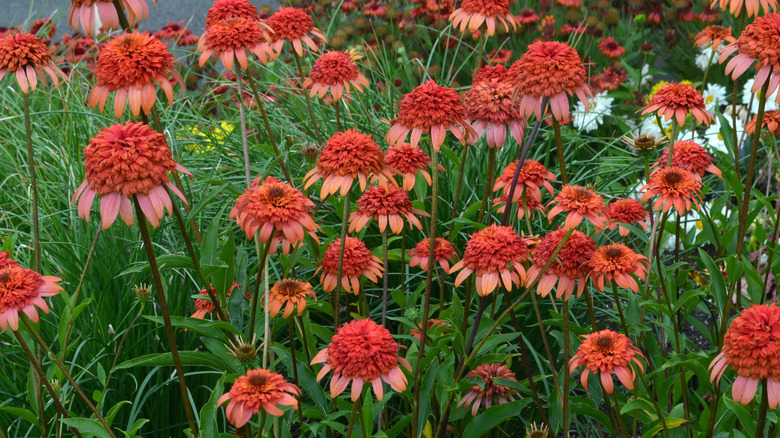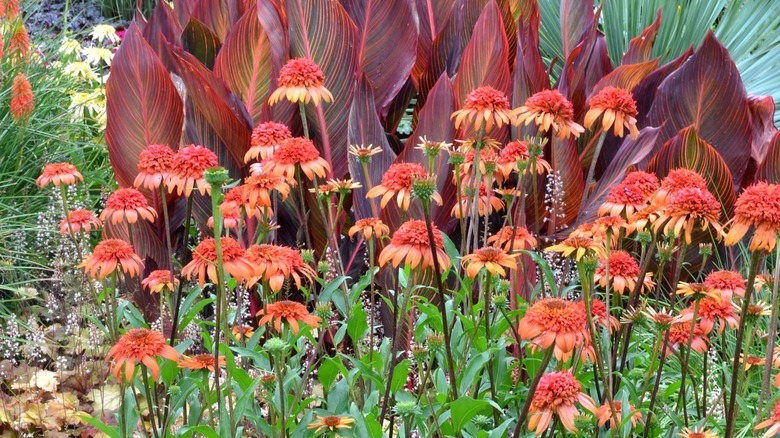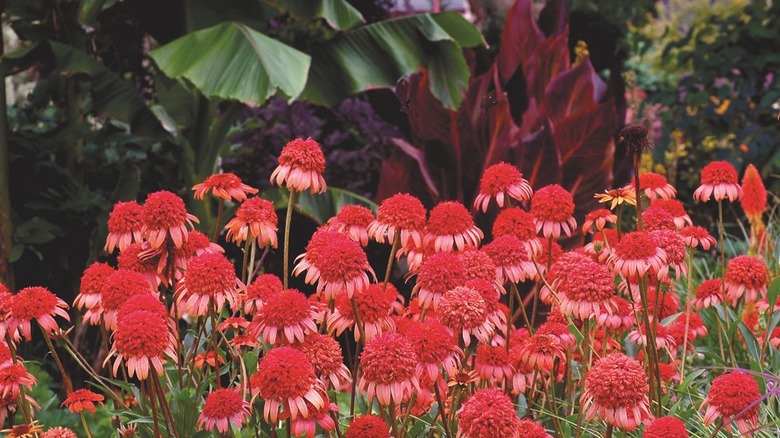Plant Secret Lust Coneflowers To Attract Birds (But There's Another Big Benefit)
Secret lust coneflowers (Echinacea "Secret Lust") are fragrant, double-flowering perennials belonging to the Asteraceae family. Native to central or eastern North America, the flowers have a central pom-pom of red-orange disc flowers surrounded by a light pink outer ray of petals. As with other Echinacea species, secret lust coneflowers are a favorite with birds. But that's not all: These hardy perennials are generally avoided by deer, making them a great option for gardens without fencing.
Secret lust coneflowers are happy in full sun to partial shade and grow well in a range of well-draining soil types. Suitable for zones 4a-9b, the flowers can bloom from spring through fall. Like other members of the Echinacea "Secret" series, these perennials can be grown as part of mixed borders, prairie plantings, wildflower meadows, and as container plants. While secret lust coneflowers attract birds to your yard, their double flowers may be less attractive to nectar-feeding insects such as bees.
Why do birds love secret lust coneflowers?
Our gardens provide an opportunity to observe a wide variety of birds. While specialized, nectar-rich flowers attract hummingbirds to your garden, it's the coneflower seeds that entice birds such as goldfinches and sparrows. Echinacea species produce an abundance of tiny seeds that these small songbirds love to eat. Food in the fall will support birds preparing for winter, whereas nourishment during spring will help birds feed their young.
After a plant has flowered it will begin to form seeds. Deadheading your garden's flowers can promote a second bloom for many flowering plants, including secret lust coneflowers. This practice works by preventing energy from being directed to seed production. However, when the coneflower flower heads are left in place, they provide a valuable food source for visiting birds. To find the perfect balance between abundant blooms and attracting songbirds, deadhead some — but not all — of your Echnicacea blooms through the growing season and leave others to form seeds. Come fall, allow all of your secret lust coneflowers to produce seed in time for the winter.
Companion flowers to deter deers
Growing secret lust coneflowers alongside other bird-attracting flowers is a great option to create a wildlife haven. And though cultivating plants in a garden frequented by deer can be challenging, there are several pollinator species that deer find unpalatable. When choosing companion plants for mixed arrangements, ensure the species share similar environmental and care needs.
As for Echinacea species, they grow particularly well alongside other wildflowers. Penstemons, commonly known as beardtongues, are flowering perennials that hummingbirds can't get enough of. This plant bears nectar-rich blossoms from May through July and also produces seeds that attract songbirds. Black-eyed Susan (Rudbeckia hirta) is another wildflower that will entice goldfinches to your garden. Producing bright to golden yellow flowers during spring and summer, this member of the daisy family also attracts an array of pollinators. Lupines (Lupinus spp.) are another great companion plant for secret lust coneflowers. In bloom from June to August, they provide nectar to hummingbirds and seeds for some game birds.
Of course, animal resistance is never a given. "As far as being rabbit and deer resistant, it's going to vary from population to population," said Chuck Pavilich, director of new product development at TERRA NOVA Nurseries, Inc., while speaking exclusively to House Digest. "Some deer and rabbits may browse them, and some will not."


